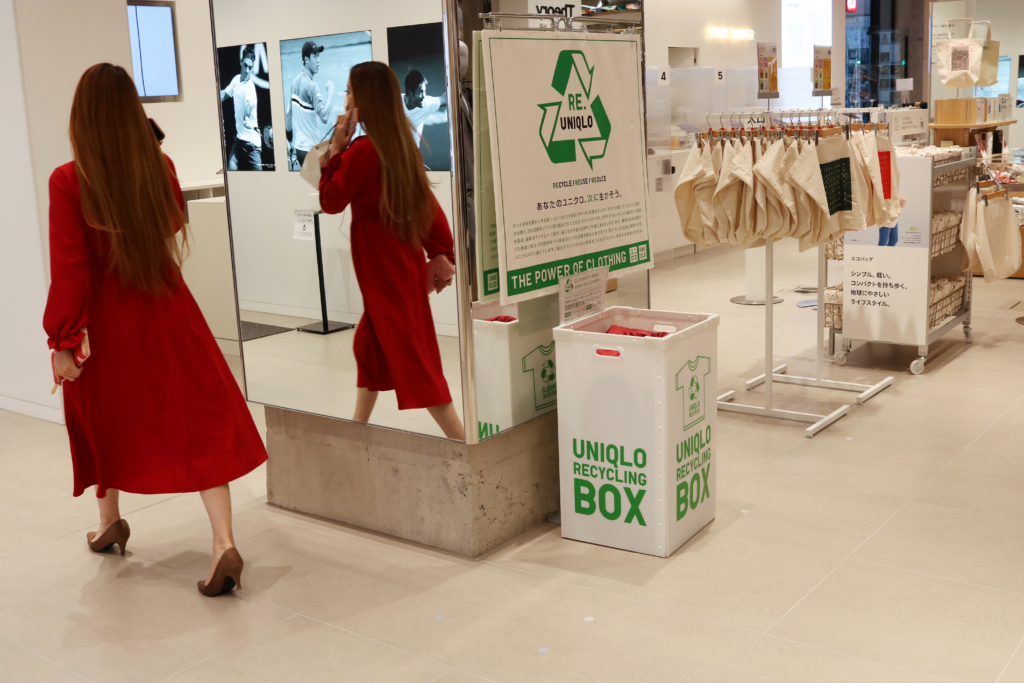Why Go Second-Hand?

As tempting as it can be to simply order brand-new items online or throw away unwanted things, there are definite benefits to taking advantage of Japan’s thriving second-hand market. While it depends on what you’re looking for, pre-loved items will generally go for lower prices. On the flip side, it’s also a great chance to make some extra money, whether you’re attempting a full KonMari or simply letting go of few unnecessary possessions. If you don’t have the time to list items or just want to do a good deed, there are also places where you can donate.
Common second-hand offerings include books, games, and clothing, but depending on where you look, you might just find that frustratingly obscure item you’ve been looking for – or maybe you’ll be the one who finally comes across someone to take it off your hands!
Where to Buy and Sell Second-hand Items in Japan
Japan has no shortage of platforms for buying and selling second-hand items, both online and offline. Be sure to consider the pros and cons for the options available in your area. For example, you might have more freedom in haggling or setting prices online, but getting rid of items quickly might be easier offline.
Japanese Online Marketplaces

If you’re just starting out, a safe choice to buy and sell online is Mercari (メルカリ), Japan’s largest community marketplace app. In December 2020, it recorded a whopping two billion items listed since it first came on the scene in 2013. As a buyer, you’ll have quite a range of items to pick from, while as a seller, you can rest assured that your listings will be seen by potential buyers from all over Japan.
While Mercari is known as a “flea market app” (フリマアプリ), its sellers tend to stick with set prices, so it’s not for those looking to drive a hard bargain. However, occasionally some will adjust prices after polite negotiation or a period of the item failing to sell.

Another convenient service is Yahoo! Auctions (ヤフオク!). True to its name, it’s an Internet auction platform backed by Yahoo! Japan, but also with the option to create regular set-price listings. Aside from this, how is it different from Mercari? One theory is that Yahoo! Auctions tends to attracts those who are more competitive over pricing, as buyers and sellers alike are are eager to take advantage of the auction-style listings. This could get you a better deal than Mercari, which is less open to flexible pricing. Of course, that doesn’t necessarily apply for all users, but it’s something to keep in mind when choosing where to buy or sell.
However, for the regular seller, Yahoo! Auctions might not be as convenient. If you’re not a premium member, you’ll only be able to list one item at a time and have limited shipping options, among other restrictions. On the other hand, the membership ties in with Yahoo!’s other shopping, travel and media services, so it may be beneficial depending on your buying and selling habits.

Second-hand goods can also be found on Amazon Japan through its Amazon Marketplace service. As you can use your preexisting Amazon Japan account, which can be set to English, it can make for a smoother experience if you don’t feel like handling a separate Japanese platform. However, remember that you’ll have to deal with Japanese product descriptions if they don’t already have English translations.
Pros for sellers include less effort in putting your items up for sale, as they will be automatically included in the overall item profiles created by Amazon. As a result, there’s no need to upload pictures or provide information on the product itself, which can be a time-consuming process on other platforms.
However, this also means that you can’t actually sell items that Amazon itself doesn’t already having a listing for. Plus, as a buyer, you won’t be able to see the actual item you’re getting – you’ll have to trust the description of its condition as a second-hand item.
Getting Started With Online Marketplaces in Japan

While each platform has its own quirks, the process to start buying and selling is generally the same. For buyers, simply create an account online and verify your phone number if needed. After purchasing an item, follow the prompts to pay, then wait for the seller to send off the item. After you’ve received it, be sure to confirm it on the platform, which will look something like 受取評価 (uketori hyōka) or 受け取り連絡 (uketori renraku).
To sell, you’ll likely need to confirm your identity through the 本人確認 (honnin kakunin) process. For this, passports and residence cards are usually included as acceptable documents, as well as drivers licences, health insurance cards and My Number cards. When it’s time to make a listing, or 出品する (shuppin suru), be sure to include a description, shipping details, and photos that will help people see what’s on offer.

When looking at or creating listings, keep in mind that second-hand items can span quite a range of conditions, or 状態 (jōtai). Common expressions used when describing products include:
- 中古 (chūko) = second-hand
- 新品 (shinpin) = new
- 未開封 (mikaifu) = unopened
- 未使用 (mishiyō) = unused
- 傷や汚れあり・なし(kizu ya yogore ari/nashi) = has marks and stains/no marks or stains
After a sale is confirmed and you’ve sent your item off to a new home, follow the prompts for 発送通知 (hassō tsūchi) to confirm that you’ve done so. When it’s safely reached the buyer, remember to leave a review. Then, receive your hard-earned cash by applying for withdrawal through a bank transfer, or 振り込み (furikomi). Alternatively, try using the balance to buy things yourself, or even for cashless payment at regular shops through apps like Mercari’s Melpay or Yahoo! Auction’s partnership with PayPay.
Buying Through Online Marketplaces in Japan

Buying through online marketplaces is generally simple as long as you have a valid payment and address. Even if you don’t have a credit or debit card, you may be able to pay through コンビニ支払い (konbini shiharai), or convenience stores. Furthermore, some shipping methods (like Mercari and Yahoo! Auction’s partnerships with Japan Post and Kuroneko Yamato) will even allow you to select a convenience store in place of a shipping address. Regardless of the platform, be sure to check the actual shipping fees too. The listing will generally read 送料込み (sōryō komi) if the price already includes shipping. Other possibilities include payment on arrival, or 着払い (chakubarai), and simple descriptions of fees depending on the area.

As mentioned before, the culture of negotiation can vary depending on the platform and seller. Mercari isn’t always the place to try out extreme bargaining tactics, but you can try leaving a polite comment like コメント失礼いたします。こちらの商品は○○円にお値下げしていただくことは可能でしょうか?(Komento shitsurei itashimasu. Kochira no shōhin wa ◯◯ en ni onesage shite itadaku koto wa kanō deshō ka?). This means, “Excuse me, but would it be possible to lower the price to ◯◯ yen?” Meanwhile, Yahoo! Auctions has a built-in negotiation function where you can enter your proposed price without further interaction. This can be accessed through the 値下げ交渉する (nesage koushou suru) link on the product page.
One more thing to look out for are sellers who set things aside at the request of a prospective buyer, even if the item is in the “buy now” category. To avoid awkwardness, be on the alert for words like 取り置き (torioki) and 専用 (senyō) in the listing. On the other hand, there are also those who use these expressions to state that they don’t do such deals, so be sure to read the full description!
Selling Through Online Marketplaces in Japan

While it feels like just about everything can be put up for sale online, be sure to confirm that your item doesn’t break any of the platform’s guidelines. For example, both Mercari and Yahoo! Auctions ban tobacco products (including e-cigarettes) and items used as weapons.
When deciding where to sell, marketplace fees are another important factor. Mercari and Yahoo! Auctions both take a 10% cut only after items are sold, but the latter drops to 8.8% for premium members. Meanwhile, Amazon Marketplace can get a little complicated – although it doesn’t cost anything to list items, there’s a fee of 100 yen per item sold, plus a referral fee that varies depending on the product category, and a variable closing fee for “media items” like books and DVDs. As a result, Mercari can be less hassle for just a few random items, while those aiming for a profit might try Yahoo! Auctions or Amazon.
Speaking of fees, you’ll likely face another when withdrawing the money earned from your sold items. Mercari charges a 200 yen fee for transfers to any bank account, while Yahoo! Auctions takes 100 yen unless you use Japan Net Bank. If you want to keep things cashless, both platforms will also let you convert your profits to a usable balance on Melpay and PayPay respectively.
Finally, if you’re looking for convenience and/or privacy when shipping items, both Mercari and Yahoo! Auctions provide easy methods through their partnerships with Kuroneko Yamato and Japan Post. When choosing the shipping methods, look for Raku Raku Mercari Bin (らくらくメルカリ便) or Yu Yu Mercari Bin (ゆうゆうメルカリ便) on Mercari and Yu-Pack/Yupacket (Otegaru Ban) (ゆうパック・ゆうパケット(おてがる版)) on Yahoo! Auctions. Perks include having a greater range of locations to send from, as well as being able to do so with just a QR code, with no need to reveal each other’s addresses. However, note that size and weight restrictions apply.
General Tips

If you see yourself buying and selling frequently on online marketplaces, take advantage of their cashless balance options, which will help you escape fees for transferring money to bank accounts. You may even get a little extra money to spend through coupons and points campaigns online or on their respective apps. Also, remember that while Mercari and Amazon Japan have active overseas counterparts, you can’t transfer existing points or listings, so be sure to make new accounts at the Japanese platforms.
Finally, it’s of the utmost importance to respond to any prompts confirming that you’ve sent or received items, as the transaction can’t officially be completed without these. Afterwards, it’s also necessary to review and rate the sale, as it will affect your overall profile as both a buyer and seller. Even if you don’t have any particular comments, you can simply thank the other with この度はありがとうございました (kono tabi wa arigatō gozaimashita).
Recycle Shops in Japan

If you prefer offline transactions, then recycle shops are for you! Japan’s most well-known recycle shops are the Hard Off stores, with numerous branches nationwide, centered around different categories. Popular stores include Book Off (books, CDs, DVDs), Mode Off (clothes, accessories), Off House (furniture, electronics), and Hobby Off (toys, figures, novelty goods). If you see an Off in the name, there’s a good chance it’s some sort of recycle shop!
While other second-hand shops don’t have the range of Hard Off, you’ll also find different stores or chains, which might deal with many categories or restrict them to just a few. For example, 2nd STREET is also a popular chain, but many of its branches specialize in clothes and accessories. If you’re not sure of the options in your area, you can search the general term リサイクルショップ (risaikuru shoppu).

So, you’ve found a place near you, but now what? Buying items at recycle shops is exactly the same as a regular store. Meanwhile, anyone looking to sell should ask an assistant at the counter for 買取 (kaitori). You’ll generally need to register with them, so don’t forget a form of ID (passports, drivers licenses, residence cards, and so on). After that, they’ll evaluate your items, which may take some time depending on the queue for that day. Then it’s time for them to state their price, which is where it can get a little awkward. It’s quite normal for recycle shops to offer next to nothing – or literally nothing, especially for common items like books and clothing. As a result, it’s best not to think of recycle shops as a source of profit, but instead as a quick way to free up space.
Other options offered by some recycle shops are 出張買取 (shucchō kaitori) and 宅配買取 (takuhai kaitori). For the former, a staff member will visit your home directly to evaluate your items, while you can send boxes directly to their location for the latter. Both methods generally require online registration and scheduling in Japanese, but it can be convenient if you don’t have the time to visit recycle shops in person.
Flea Markets in Japan

If you have the time, why not try a good old-fashioned flea market? As these tend to be held irregularly, with some only in certain seasons or in conjunction with other events, try searching フリーマーケット (furī māketto) or checking the calendar at フリマガイド for upcoming markets near you. Like recycle shops, the balance is definitely tipped in casual buyers’ favor – getting set up at a flea market will require time and money to turn a profit, as sellers generally have to pay a fee for their own stall or area. However, one thing that buyers should remember is that there likely won’t be much room for negotiation, as the bargaining culture in Japan is quite weak.
Online Communities in Japan

Prefer dealing in English? Facebook groups like Sayonara Sales could be a good option for you. Generally split up by area, such groups stereotypically feature posts from expats who are moving house or leaving Japan – thus the name Sayonara Sales, although not all are named exactly the same. After finding one that’s active in your area, log in or create a Facebook account to join the group. When you become a member, you’ll be able to sell and buy items by creating posts, commenting and messaging people directly.
Websites hosting online classifieds like GaijinPot Japan Classifieds and Craigslist also attract English speakers, making it quite easy to navigate. If you want even more variety, check out Jimoty for Japanese listings. While both GaijinPot and Jimoty require registration for both buying and selling, Craigslist can be used with just an email address.

Buying and selling items through the above methods is a great chance to get rid of things or get a good bargain within your area, as many people specify pick-up only with payment by cash. This is especially common for bulkier items like home appliances and furniture. However, some sellers are also happy to ship to different areas, so there’s no harm in asking if they haven’t already stated their preference.
Another tip for buyers is to wait until Japan’s moving season, before the new school and fiscal year begins in April. With more people eager to say goodbye to unneeded things quickly, it’s likely that you’ll be able to snag better bargains and big-ticket items.
While we’ll talk a little more about donating below, you’ll also find that things listed for free are also quite common in these online communities. For groups created specifically for exchanging and donating items, try searching the word “mottainai” (Japanese for “what a waste!”). While the original Mottainai Japan group is open to residents nationwide, there are also many spinoffs that focus on certain areas.
However, one downside to these online communities is the lack of a special payment system or official support should something go wrong. If a package doesn’t arrive or a buyer doesn’t show up, you can make a complaint to the group or website admin, but you might have to give up on that particular transaction. That being said, most users are regular people looking to buy and sell, so just be sure to exercise caution and think about whether something is too good to be true, as you would for any other second-hand items.
Where to Donate Second-Hand Items

If you don’t have the time to look for buyers, try giving back! It depends on the type of item, but donating can be quicker and easier than waiting for items to sell. Plus, it always feels great to just do a good deed.
Recycling Programs in Japan

If you have clothes to spare, brands like Uniqlo, H&M, and Zara accept them for reuse and recycling. They can be dropped off at the counter or boxes in store, but check the conditions set by the company before coming in. For example, Uniqlo will accept Uniqlo products only, while H&M takes clothes of any brand and condition – and they’ll even gift you with a 500 yen voucher for a bagful.
Another method worth researching is local programs that accept donations, or 寄付 (kifu) – for example, Mottainai Flea Market in Tokyo collects usable second-hand items to sell, with proceeds going to The Green Belt Movement, a Kenyan-based project which seeks to promote environmental conservation and empower communities. There might also be a library or community center near you looking for books, toys, and so on.
Reduce Waste and Clutter by Going Second-hand!
There are plenty of reasons to make the most of the second-hand market in Japan. Not only is it a greener alternative to trashing unwanted things, but it’s also a great opportunity to get rid of clutter and enjoy preloved items at more affordable prices. Why not give it a try?
If you want to give feedback on any of our articles, you have an idea that you’d really like to see come to life, or you just have a question on Japan, hit us up on our Facebook!
The information in this article is accurate at the time of publication.

